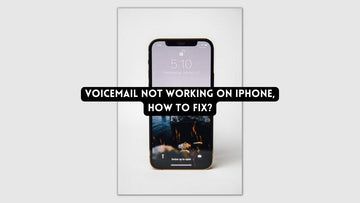How to fix Macbook screen glitching and flickering - 9 Tips & Tricks!
by Chelsea Bruhl on Sep 26, 2024

MacBooks are essential tools for many people's jobs. They are powerful devices that can be used for everything from simple text authoring to running programs and graphical simulations. In recent years, Apple has steadily changed the scope of its MacBooks. Users have recently been affected by quality control concerns in the hardware and software sectors. The odd screen flashing out of nowhere is one of the most noticeable MacBook problems.
Mac displays often have a fantastic and high resolution, which is what makes them appealing and popular among its users. However, in recent months, it has been noted that Mac displays have begun to flicker in numerous color lines or horizontal lines/blocks. When you spend a lot of money on a MacBook and the screen begins flickering constantly, it looks terrible. Unfortunately, the flickering on the MacBook screen is more common than you may imagine. Although there are a few hypotheses, no one understands why it happens. Most importantly, you can correct it right now by taking a few steps. Let's look at some of the solutions to the question, "How can I stop my screen from flickering?" and bring your MacBook back to normal.
Why does the Mac screen keep flickering?
The flickering screen affects both retina and non-retina screens, and Mac users have reported that it occurs when using Terminal or when graphics are active or off. It's so terrible in certain situations that it's hard to look at the screen.
The following might be the reasons for the frequent flickering issues:
- Faulty software updates might cause screen flickering, so it's best to maintain your MacBook Pro's software up to date. If there is a pending software update, install it right away since new updates come with new security measures, and your outdated software may clash with them, causing a problem later.
- The absence of CUDA drivers has been linked to the MacBook Pro Screen Flickering issue. As a result, make sure your Mac's drivers are up to date so that screen flashing isn't an issue.
- If you have recently dropped your Mac or it has accidentally slid from your hands, you may suffer the MacBook pro flashing black issue. This can potentially harm the screen, causing it to flash dark or various colors as a result of the incident.
- Check to see if you're getting the correct voltage for your device since lower or greater voltage might create significant problems with your Mac's display.
Macbook Screen Glitching and Flickering Fix
Restart your MacBook
Even though it is every IT person’s favorite dialogue, it does sometimes do wonders and fix the issues. When you have any system problem, a simple restart of your Mac can solve 80% of your issues. As your Mac restarts, it reconnects with all of its internal hardware, and certain incompatibilities may disappear.

To restart your Mac, follow these steps:
- In the menu bar, select the Apple symbol.
- Choose Restart...
- To confirm, press the Restart button.
Update your macOS
Updates are an important element of keeping gadgets running properly, and this is true for MacBooks as well. Updates not only provide new features and increase security, but they also repair bugs and address any known problems. As a result, it's critical to keep your MacBook up to date.
Follow these steps to update your MacBook:
- On your MacBook, go to System Preferences.
- Select Software Update from the drop-down menu.
- If a new version of the software is available for download, click Update.
Adjust Energy Savings Settings
The MacBook screen flickering might be caused by the Energy Saver not operating properly if you have a MacBook Pro. If you activate Automatic graphics switching under Energy Saver, your Mac will switch between two graphics chips depending on how often it is used.
The system will use an Intel-integrated graphics card for simple operations, while the dedicated graphics card will handle the heavy duties. Only Macs with Intel CPUs will be able to do so.
To stop automatic graphics switching on a Mac, follow the instructions below:
- On your MacBook, go to System Preferences -> Energy Saver
- Uncheck the option labeled "Automatic graphics switching."
Disable True Tone Display
Since 2018, It is possible to alter the color of your Mac's display according to the time of day and lighting conditions with a new feature called True Tone. Similar programs exist for earlier Macs, the most popular of which being f.lux. In addition to being visually pleasing, True Tone demands ongoing GPU engagement, which could be the source of your screen flickering.
In order to turn off True Tone:
- On your MacBook, go to System Preferences -> Displays
- Uncheck the option labeled "True Tone"
If you're using f.lux on an older Mac, simply exit the application and see if the screen flickers have stopped.
Optimize your Mac systems
Glitches on the MacBook screen can be caused by a variety of circumstances. If a simple restart does not address the problem. You don't have any other option except to diagnose it. And doing it one by one might be a real hassle. While you can take it to a repair facility, even if it's just for an optimization issue, it will cost you money. As a result, it's best to rule out all alternatives before entrusting the situation to the professionals.
Do note that you should be cautious while dealing with these issues because deleting the wrong file or putting an important file in the wrong folder can worsen the problem. As a result, the ideal solution is to use a dedicated application to do it for you. Optimization software tools like CleanMyMac X are incredibly dependable and simple to use. Simply run the software to remove any unnecessary files from your Mac.
You can also erase outdated user logs and flush the DNS cache. You can also free up some RAM to see whether this is a problem. Most crucially, you can reindex Spotlight/Hard drive, among other things. Trying each of these ideas one at a time can help you get closer to solving the problem.
CleanMyMac X, for example, can even keep track of other apps and their upgrades, which is very remarkable. This is useful if you have a malware problem because you can erase it fully, including all of its files.
Reset your Mac’s SMC
If none of the aforementioned methods succeeded, the issue is most likely rooted in low-level processes. The System Management Controller (SMC) could be at blame for the screen flickering.
The SMC in a MacBook is in charge of a variety of self-contained functions. Battery and power management, as well as other systemic tasks, are among these functions.
If your MacBook's SMC has been corrupted, you can solve the screen flickering by resetting the SMC. Follow these instructions carefully to reset the SMC on your MacBook:
- Save all of your work and files, and then exit any open applications.
- Shut down your MacBook now.
- Once it's turned off, press and hold Control + Option + Shift for at least seven seconds.
- After seven seconds, hit the power button for an additional seven seconds, in addition to the above keys.
- Release all of the keys, wait a few seconds, and then restart your MacBook.
Reset NVRAM and PRAM on Mac
Resetting the NVRAM (Non-Volatile Random Access Memory) and PRAM (Parameter Random Access Memory) can help if resetting the SMC didn't work.
A faulty NVRAM or PRAM could be the source of the screen flickering problem. Faulty memory can cause the graphics card to fail, which could be the cause of the flickering problem.
The bugs will be removed and the issue may be resolved by resetting both the NVRAM and PRAM. Follow these steps to reset them, which are similar to those for the SMC:
- Turn your Mac off.
- For around 20 seconds, press and hold these keys, Control + Option + P + R, until the Apple logo appears and disappears for the second time.
Before resetting NVRAM and PRAM, take in mind that it may reset the display, startup disc settings, and time zone to factory defaults. You don't have to worry about it because you can easily alter them back to your preferred settings later.
Restart Mac into Safe Mode
Any of the previous techniques should have fixed the problem, but if they didn't, you can try again by restarting your MacBook in safe mode. Only the most critical Mac functions will be activated, and the performance of your graphics card will be stabilized.
Follow these instructions to restart your MacBook in Safe Mode:
- Turn off your MacBook.
- Now, while holding the Shift key, turn on your MacBook.
- When prompted to log in to your MacBook, release the Shift key.
- You can switch off your MacBook and turn it back on normally if the screen flickering problem isn't present in Safe Mode.
- In regular mode, this should have also fixed the screen flickering issue.
Contact Apple Support
If none of the preceding approaches worked, the issue could be with the display itself. It could be a faulty display or a loose connector. Whatever the case may be, the best course of action is to contact Apple via the official Apple Support website or to visit an authorized Apple repair shop. Apple will locate and resolve the problem for you.
Conclusion
The MacBook screen glitching/flickering issue has been a long-standing problem for many MacBook users. It's a frustrating situation, but it's what it is. Unless the issue is hardware-related, the solution is straightforward.
While Apple Support is excellent, it is not practical or effective to use it all of the time. And, if the issue is a minor bug or incompatibility issue, it is advisable to investigate it yourself. These are quick and straightforward repairs that only take a few minutes. To fix the screen glitching/flickering issue on your MacBook, follow the steps above and let us know whether it worked.





